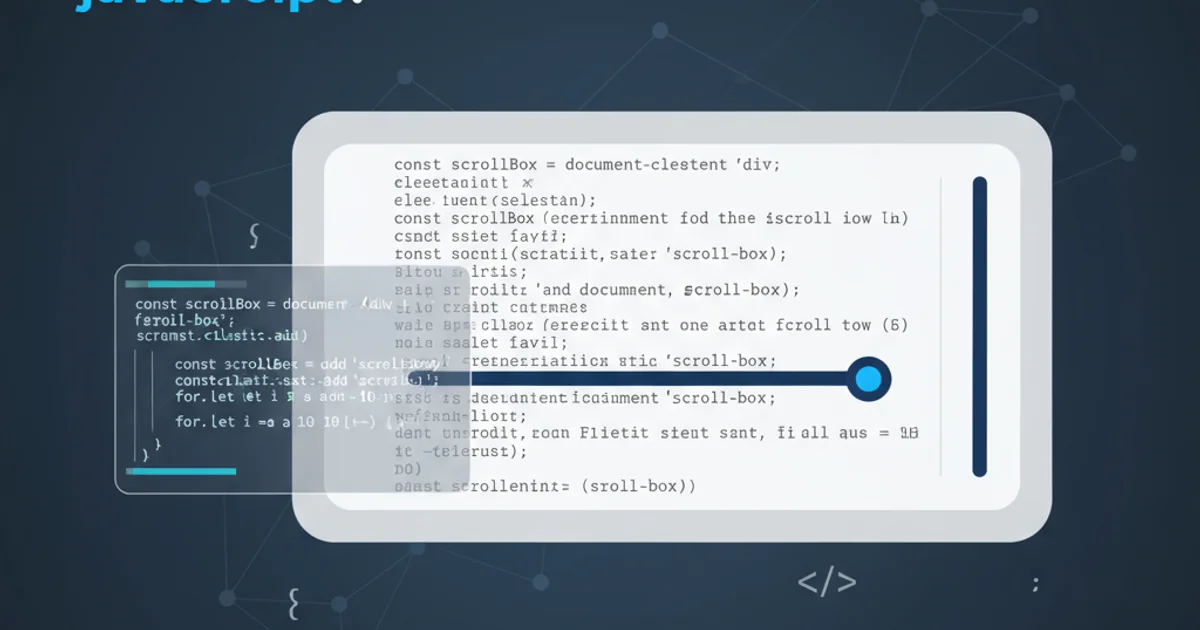ASP.Net Ajax and Postback
Categories:
Understanding ASP.NET AJAX and Postbacks: A Developer's Guide

Explore the fundamentals of ASP.NET AJAX, how it interacts with the traditional postback model, and techniques for building more responsive web applications.
ASP.NET Web Forms, while powerful, traditionally relied heavily on the 'postback' model, where the entire page is reloaded for every user interaction. This often led to a less responsive user experience. ASP.NET AJAX was introduced to bridge this gap, allowing developers to update parts of a page asynchronously without a full page refresh. This article delves into the core concepts of ASP.NET AJAX, its relationship with postbacks, and how to effectively use it to enhance your web applications.
The Traditional ASP.NET Postback Model
In a classic ASP.NET Web Forms application, every user action that requires server-side processing (like clicking a button, selecting an item from a dropdown, or submitting a form) triggers a full page postback. This means the browser sends the entire page's view state and form data to the server. The server then processes the request, rebuilds the page, and sends the complete HTML back to the browser, which then re-renders the entire page. While simple to implement, this approach can be inefficient and lead to a 'flickering' effect as the page reloads.
flowchart TD
A[User Action (e.g., Button Click)] --> B{Browser Sends Full Page Data}
B --> C[Server Processes Request]
C --> D[Server Rebuilds Full Page HTML]
D --> E{Browser Receives Full Page HTML}
E --> F[Browser Re-renders Entire Page]
F --> G[Page Displayed to User]Traditional ASP.NET Postback Flow
Introducing ASP.NET AJAX: Partial Page Updates
ASP.NET AJAX (Asynchronous JavaScript and XML) provides a framework for performing partial page updates. Instead of reloading the entire page, AJAX allows specific regions of the page to be updated asynchronously in the background. This is achieved primarily through the ScriptManager and UpdatePanel controls. When an event occurs within an UpdatePanel, only the content within that panel is sent to the server, processed, and then returned to the client to be updated, resulting in a much smoother user experience.
<asp:ScriptManager ID="ScriptManager1" runat="server"></asp:ScriptManager>
<asp:UpdatePanel ID="UpdatePanel1" runat="server">
<ContentTemplate>
<asp:Label ID="lblTime" runat="server" Text="Current Time:"></asp:Label>
<asp:Button ID="btnRefresh" runat="server" Text="Refresh Time" OnClick="btnRefresh_Click" />
</ContentTemplate>
</asp:UpdatePanel>
<asp:Label ID="lblOutsidePanel" runat="server" Text="This content is outside the UpdatePanel."></asp:Label>
Basic UpdatePanel implementation in ASP.NET
protected void btnRefresh_Click(object sender, EventArgs e)
{
lblTime.Text = "Current Time: " + DateTime.Now.ToLongTimeString();
}
Code-behind for the Refresh Button click event
flowchart TD
A[User Action (e.g., Button Click)] --> B{Event Triggers UpdatePanel}
B --> C[AJAX Request Sends Partial Data (UpdatePanel content)]
C --> D[Server Processes Request]
D --> E[Server Returns Partial HTML (UpdatePanel content)]
E --> F{Browser Updates Only UpdatePanel Content}
F --> G[Page Displayed to User (without full refresh)]ASP.NET AJAX Partial Page Update Flow
Understanding Asynchronous Postbacks vs. Synchronous Postbacks
When you use an UpdatePanel, the postback that occurs is an asynchronous postback. This means the browser sends the request in the background without interrupting the user's interaction with the page. The page doesn't fully reload. In contrast, a traditional postback is a synchronous postback, where the browser waits for the server's response before allowing further interaction, leading to the full page refresh. It's crucial to understand that an UpdatePanel doesn't eliminate postbacks; it merely converts them into asynchronous ones, making them less disruptive.
UpdatePanel simplifies AJAX, it can sometimes mask underlying performance issues. For complex scenarios or fine-grained control, consider using jQuery or custom JavaScript with WebMethods or Web API endpoints for more explicit AJAX calls.Common Challenges and Best Practices
While UpdatePanel is convenient, it's not a silver bullet. Overuse can lead to performance issues if too much content is placed inside, or if nested UpdatePanels are not managed carefully. It's also important to handle JavaScript that needs to run after an asynchronous postback, as the document.ready event won't fire again. The PageRequestManager client-side API can be used to hook into AJAX lifecycle events.
Sys.WebForms.PageRequestManager.getInstance().add_endRequest(EndRequest);
function EndRequest(sender, args) {
if (args.get_error() == undefined) {
// Code to run after an UpdatePanel update completes successfully
console.log('UpdatePanel content refreshed!');
} else {
// Handle errors
console.error('UpdatePanel error:', args.get_error().message);
}
}
Using PageRequestManager to execute JavaScript after an AJAX postback
UpdatePanels. This negates the benefits of partial rendering and can increase bandwidth usage unnecessarily. Focus on updating only the dynamic parts of your page.